
Poses, Stretches,
Exercises
--- 'E-cises' ---
of the Pete Egoscue
book, "Pain Free"


|
Poses, Stretches,
|

|
! NOTE !
I did NOT find that any of these E-cises helped me
with a 'lower back pain every morning' problem.
But I found a simple 'lunge stretch' was my solution,
as described on this
lower back pain page.
Table of Contents:(links to sections below, on this page)
Some SEARCH engines
End of Table of Contents.
Note: |
INTRODUCTION to
|
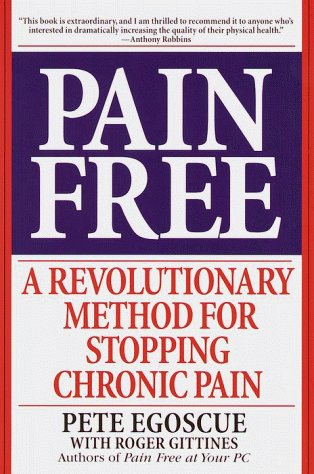
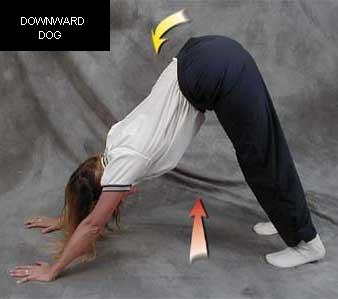
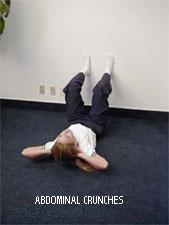

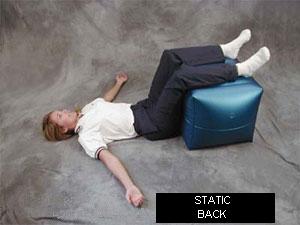
|
Many of these 'E-cises' are yoga poses and stretches that can be seen in yoga or stretching books/magazines/ads. Some 'E-cises' are exercises --- such as a type of sit-up or push-up. Some e-cises are perhaps devised from Egoscue's own dealings with his war wounds. In any case, the e-cises seem be a compendium of what might be called "what works for many people, no matter the source". You can see pictures of some of the e-cises, along with their descriptions, at the Egoscue web site. Click on parts of the human body shown there. There are some e-cises at the egoscue.com web site that are not in the "Pain Free" book. Examples:
Some of these e-cises have been added to the Standing-Sitting-Kneeling-LyingDown tables herein. (Click on the "body-orientation" links on this page.) BASIS of the METHOD:The Egoscue method is based on the observation that a lot of body pain is due to the body getting out of balance for various reasons. A common example is the hunched posture seen in many older people. Another example is the changes people make in their stride/stance/posture in response to past injuries. Egoscue points out that there are four main pairs of load-bearing joints in the standing human body --- at ankles, knees, hips, and shoulders. |
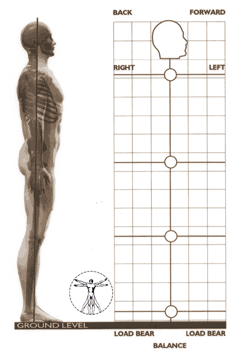
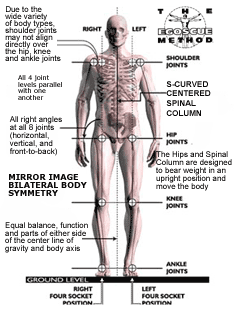
ORGANIZATION of the BOOK:After a few introductory chapters, the book starts presenting specific e-cises. The initial chapters (after the introductory chapters) present specific e-cises, intended to bring balance, flexibility, and strength to the human body, especially around the FOUR LOAD-BEARING AREAS. These chapters also deal with body areas that are COMMON SOURCES OF PAIN. Those initial chapters deal with (starting at the bottom of the body)
Later chapters in the book present e-cises repeated from the feet-to-knee-to-hip-to-shoulder-to-head chapters (and present some new e-cises) oriented toward various SPORTS:
These groups of e-cises are followed, near the end of the book, by a suggested group of e-cises for MAINTAINING balance-flexibility-strength. EVALUATIONS of the BOOK:Some evaluations of the book and the method can be seen at amazon.com. Read the 1-star and 2-star reviews to learn of people who did NOT get benefit from the Egoscue exercises and poses. One reader-evaluator points out that most of the "e-cises" are poses rather than exercises. I find that many of the 'static' poses (like "air chair" and "downward dog") are quite invigorating. They increase your breathing rate and increase blood flow to various areas of the body. Hence, in spite of being 'static', those e-cises are as invigorating and strengthening as many 'dynamic' exercises. Another reader, at amazon.com, a doctor, says he believes the exercises reduce pain because of the adrenaline or endorphin rush precipitated by many of these exercises. I think it goes beyond this, because a day or two after doing these e-cises, you can still feel the effects. Furthermore, I have felt benefits for many weeks, and I expect those benefits to be long-lasting. In particular, I have found relief from leg cramps. By doing certain kinds of toe-pointing stretches, I can maintain freedom from the leg cramps that used to suddenly strike me with agonizing pain, when I happened to point a toe a certain way. Many readers point out how they started feeling benefits after only one or two e-cise sessions. I too felt significant benefit after only a couple of sessions --- probably because I was coming to this after a couple of years of long, uninterrupted hours of very sedentary work and (dumb me) after a suspension of the exercise I used to get several days a week. That inactivity led to a knee injury and knee surgery, which added more months of low activity level for me. So I came to the e-cises with a history of a couple of years of very little athletics or exercise. I also had spent many years eating high-sugar, high-starch foods and had thus driven my blood triglycerides sky-high --- with the result that the capillaries in my extremities and elsewhere (especially in poorly perfused cartilagenous areas like knees) had started shutting down. I had drastically changed my diet about a year before coming upon these e-cises. I cut out most added-sugar (esp. in "soft" drinks and iced tea) and cut out most potatoes (high starch). But I think these e-cises were instrumental in helping my capillaries recover, thus improving blood flow to feet, knees, etc. I conclude from this that a well-exercised, well-eating athlete may NOT feel a great deal of additional invigoration or strengthening benefit from the e-cises. But athletes can almost certainly gain from the flexibility benefits ...... and gain from a reduction of cramping (especially in the legs) --- if the athlete has done little stretching ...... or if he/she has not done the wide variety of poses-exercises seen in this book. Furthermore, athletes trying to recover from injuries MAY benefit from SOME exercises/poses in this book. The NUMBER of E-cises:I found, in an initial read of the book, that only about four or five e-cises are presented for each section of the body (or for each sport) --- and many of those e-cises are repeated in the various sections of the book. Because of this, I got the impression that there are only about sixteen e-cises in the book. But if you look under E (E-cises) in the index at the end of the book, and count the entries with capital letters (the e-cise names), you will find about 40 e-cises. VARYING EFFECTS of E-cises:I have found some of the e-cises seem to have very little stretching or invigorating effect on me --- perhaps because I am not tight or out-of-alignment in the areas they are meant to target. Other e-cises seem to be very invigorating or beneficial for me --- and I would want to continue to use them in a maintenance program, even though they are not mentioned in the maintenance program Egoscue proposes at the end of the book. I think you would find it helpful to try out all the exercises in the book (about 40). Then alter the suggested e-cise lists in the book-sections that are of interest to you ---
In other words, assemble a program tailored to your own pains, weaknesses, misalignments, and tightnesses. In fact, tailoring-of-programs is one of the services offered through www.egoscue.com. But you can probably just pick out the e-cises that best address your particular condition(s). An ALTERNATE GROUPING of e-cises:I find it invigorating to use some of the exercises when I am STANDING or SITTING somewhere (for example, while watching a sports event at an arena or field, or while in front of a television or computer terminal). In addition, there may be occasions (other than at home) when you can KNEEL or LIE DOWN to do some e-cises for a minute or two, or more. I found it helpful to have a list of the e-cises categorized into the various exercise positions:
The book does not provide such a list, so I have assembled such a list (by body orientation) in the standing-sitting-kneeling-lyingdown tables available through this web page. You may wish to capture (print) the lists (tables) --- for your easy reference --- and to help you assemble various lists of e-cises that you find most beneficial for you. |
Egoscue poses/exercises
|
|
For more info: To find more information and images on the Egoscue system of 'E-cises', you could try some WEB SEARCHES on keywords such as : |
|
Bottom of this To return to a previously visited web page location, click on the Back button of your browser, a sufficient number of times. OR, use the History-list option of your web browser. OR ...
< Go to Table of Contents, above. >
Or you can scroll up toward the top of this page. Page history:
Page was created 2006 Sep 13.
|